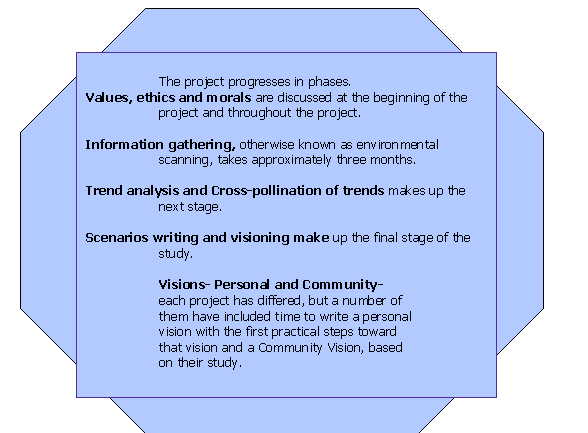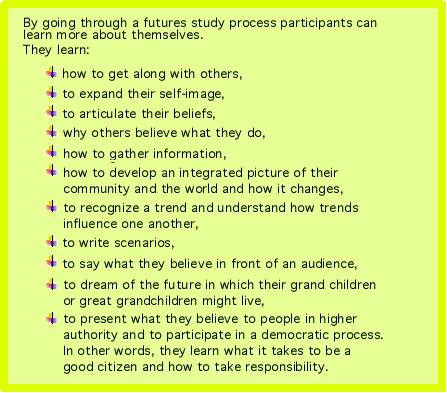| |
DESCRIPTION OF THE METHODOLOGY CALLED FRAMTIDSBYGGETTM OR BUILDING THE FUTURE
A YEAR LONG COURSE IN FUTURES STUDIES.
Visionscentret Framtidsbygget in Sweden has guided 170
people through a research project called FramtidsbyggetTM.
"Building the Future".
Background
The title of this concept, "Building the Future", uses
the word "future" based on a new area of study called
Futures Studies which began to take form in the 1960's.
Bertrand de Jouvenel who started The Futuribles Group
developed a new use of the word future in France directed
at decision-makers. The Group's futures research is
known as la prospective in French. La prospective is
based on five specific steps, which result in scenarios.
Rand Corporation, which began as a military think tank
in USA, developed a variety of techniques to be used
in Futures Studies; Delfi and Cross Impact Matrix being
two examples. In the ensuing years the techniques of
both groups have evolved so that many academics, consultants,
and companies integrate scanning, trend analysis and
scenario techniques into their business life. Working
in Germany Austria and Switzerland, Robert Jungk worked
with the future in a different way. 1962 began to run
future workshops for workers. His goal was to help people
to actively take part in the creation of their own futures.
Beginning with a problem statement, and including brainstorming,
prioritizing, fantasy and creativity, the participants
developed action plans, which they then followed.
"Building the Future" actually combines all of these traditions and has added other important dimensions as well.

The Vision Center has added values, to their studies of the future. We have also added knowledge about learning styles and the latest brain research so that participants carry out their study in accordance with their own personal learning and work styles.

Natalie Dian brought Futures Studies to Sweden in 1985, but it wasn't until 1992 that she and Christel Nilsson developed a model, which trains individuals to apply these techniques to both their work, and their everyday lives. The model is much more than learning futurist techniques. In the spirit of Junk, it helps individuals to be proactive in creating the future (by developing scenarios and visions for the community and themselves) while developing competence in social skills. It is also an inspiring model for adult learning, very important in view of the life-long learning in which we all must participate.
Facts
Each of the studies completed was of different systems,
the future of the public
sector, the future of a sustainable
society, the future of work and jobs, etc.
Each study was conducted by 35 hand chosen people who
were unemployed at the time.
The groups differed; three were for youth between 18 and 27, one for women between 35 and 55, and one for men and women between 25 and 50. After a successful result in the initial project, The Vision Center, 1996, trained project leaders for NBV's project in Sweden "Trendbryterna". They in turn led two Transnational Employment Youth Start Projects financed by the European Union social fund. They were developed in order to spread the concept and to test the replicability of the model. The two programs for young people between 18 and 24 were held in various parts of Sweden. After successful results, one of the project leaders went on to implement what she learned in teacher training courses and her own classroom. Another expressed herself in book form, "Vilken
framtid vill du ha Svensson?", (What Kind of Future Do You Want Svensson?), which challenges the citizens of Sweden to take part in the changes that were occurring around them. Still others dropped the futures element and went on to emphasize, values, learning to learn and personal development in combination with one to one counseling in successful projects for youth.
The participants were chosen for their different backgrounds, cultures and work experiences.

Three thoughts lie behind the choice of speakers, materials and exercises that participants receive in order to carry out their futures study:
- We are moving from linear thinking to systems
thinking.
- Brain research is teaching us that there are
different kinds of intelligence's and that adults
and children have to be taught in accordance with
their own unique combinations of intelligence.
- We know that most children do not have a positive
experience of school and learning. Adult education
must help adults' experience learning as a positive
activity as they must continue to learn for the
rest of their lives.
The pedagogic model of FramtidsbyggetTM
The pedagogic model of FramtidsbyggetTM
was drawn from many sources. Some of the concepts
behind it are:
People learn best when doing something constructive,
when they see the purpose of their work (creating
a vision or scenarios).
People learn best when they can find the information
themselves, and when it is a subject they are already
interested in (environmental scanning).
People learn from each other as much as they can learn
from a teacher (most work takes place in groups and
each participant is expected to share what they have
learned and developed with the other participants,
a cross-disciplinary approach).
People learn best when they see how subjects are integrated
(they began to understand that all of the variables-
subjects they scan are linked into one huge system
made up of smaller systems).
People learn best when they have a combination of
structure and control over their learning (the process
provides control, but the researchers have much to
say about the way their work will be done).
People learn best when they understand their own learning
style (each participant is given a test to determine
their learning and working styles, these are then
discussed with a professional).
People learn best when information is presented to
all of the senses (many different learning techniques
are incorporated into the program, exercises, discussions,
movement, music, dramatization and simulation).
People have a need to see the whole picture as well
as the details (participants work with details, which
come together in a "whole" during scenario writing).
People have a need to learn techniques that can last
them their whole lifetime, not just till the next
test (participants learn how to read the news differently,
think broader and more systemically, learn techniques
for working with a diverse group of people and understand
the process the world is currently undergoing and
much more).
People learn best when they evaluate their own results
and when their success is measured against their own
previous results.


|